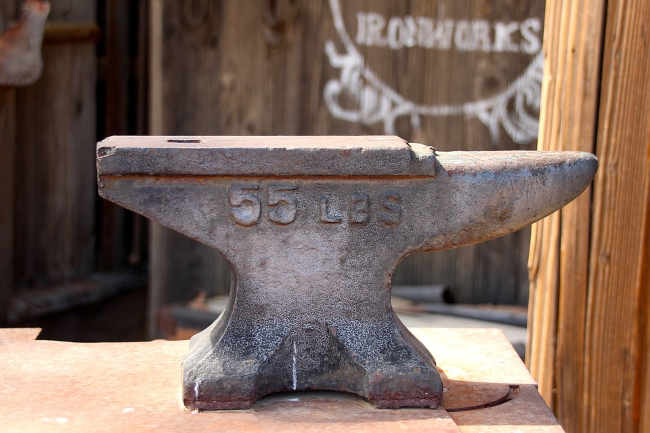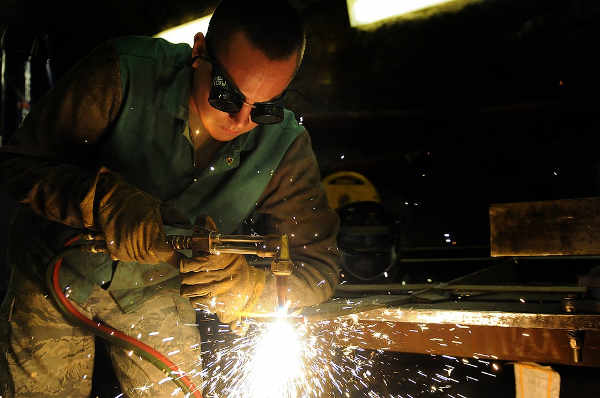Blacksmithing and welding are just two of many different types of metalworking that people do today. They’re quite different professions, but they may also have more in common than you think.
What’s the difference between blacksmithing and welding? A blacksmith uses a hammer and their anvil to shape metal. They use a forge to heat their metal to a hot enough temperature that it can be bent and worked with. A welder uses a welding torch to get two pieces of metal hot enough that they can get fused together into a single piece. The earliest form of welding was called forge welding, and it was done by blacksmiths who got pieces of iron or steel hot enough to hammer them together.
In this article, we’ll learn the difference between blacksmithing and welding, as well as other types of metalworking. As well as looking at some other related professions like whitesmiths and farriers.
What Is Metalworking?
Metalworking is a general name for any process that someone uses to turn a piece of metal into a product.
Both welding and blacksmithing are types of metalworking.
Metalworking includes:
- Cutting processes like milling, threading, grinding, filing, milling, and others.
- Joining processes like soldering, riveting, brazing, and welding.
- As well as other processes like plating, casting, thermal spraying, and heat treatment.
The oldest form of metalworking we know of was a copper pendant created in Iraq around 8,700 BCE. Other metals that ancient civilizations knew about and were able to work with included gold, silver, mercury, lead, tin, and iron.
Blacksmithing is believed to have began during the iron age, around 1,500 BC. And the earliest modern form of welding was done around 1836, although it didn’t become practical for large-scale use until around 1900.
What Is Blacksmithing?

Blacksmithing is a compound word that consists of two individual words.
The black part comes from the color of fire scale and oxides that form on heated metal, causing a black color. The smithing part comes from the word smite, which means to hit.
A blacksmith is someone who forges metal to create objects. They almost exclusively work with iron and steel. Although there are some goldsmiths and silversmiths as well.
Blacksmiths use tools to shape the metal they work with. They cut, bend, and hammer to create gates, tools, grills, decorative items, sculptures, railings, and more.
Blacksmiths heat their metal using a forge, which is fueled using coal, coke, charcoal, natural gas, or propane. Modern blacksmiths also sometimes use blowtorches to provide a more localized form of heating.
A skilled blacksmith can determine the color of a piece of metal by its color. Iron and steel change from red to orange and yellow, and eventually white before reaching its melting point.
Most of a blacksmith’s work is done when the metal is in the yellow to orange color range. At this point, the metal is soft enough to work with and shape.
Blacksmiths use hand tools like hammers, anvils, tongs, and chisels. The majority of their work is done with only a hammer and an anvil.
(To see what tools I suggest, check out my recommended gear page!)
With blacksmithing, material doesn’t get removed like it might in modern machining. Instead, it simply gets hammered into a specific shape, with very little waste. Even when holes are punched into the metal during blacksmithing, it usually gets rearranged and reincorporated into the work rather than being completely removed.
What Is Welding?

Today, welding is the cheapest and most efficient way to permanently join two pieces of metal together. Basically, welding gets two pieces of metal very hot so they can melt together and fuse. Welding is used in everything today from coffee makers to skyscrapers to spaceships.
Welding is a more modern form of metalworking than blacksmithing. A welder usually uses an electrical arc (stick welding), an oxy-acetylene torch (oxy welding,) metal inert gas (MIG welding), or tungsten inert gas (TIG welding.) Different types of welding are used for different applications, and each comes with its own pros and cons.
Can Blacksmiths Weld?
Up until the 19th century, the only type of welding was forge welding. This type of welding was done by blacksmiths for thousands of years to join together steel and iron using hammering and heat.
To forge weld, a blacksmith gets two pieces of steel extremely hot, usually 2,000 degrees F or above. Then they are layered on the anvil and smashed together with a heavy hammer. This force merges the two pieces of steel together into a single piece if done correctly.
So you could say that all blacksmiths can weld… but not all welders are blacksmiths!
The main difference between blacksmithing and welding is about 400 degrees. Also, welding is semi-automatic, while blacksmithing is much more of a manual process.
What Is A Whitesmith?

A whitesmith is also known as a tinker, tinman, tinsmith, or tinner. They make and repair things that are made out of tin and other lightweight metals.
While blacksmiths do most of their work with hot metals, whitesmiths do most of their work with cold metal. They make items like candle holders, spoons, forks, and water pitchers.
Much like blacksmithing, working with tin is pretty much just a hobby now and not done professionally on any real scale. The closest modern job is probably a sheet metal worker.
What’s The Difference Between A Blacksmith And A Farrier?

A farrier is a specialized type of blacksmith, which is also part veterinarian.
A farrier makes horseshoes and fits them onto a horses foot immediately and attaches them with nails.
Being a farrier is a very hard and physical job. Not only does it require the skills of a blacksmith, but they also need to deal with large and difficult to control animals.
Farriers are one profession with blacksmith training that are still in demand today. Since horseshoes need to be individually made to custom fit specific horses, there is no real way to automate the process like other types of metal working.
Conclusion
Welders are basically a modern and specialized equivalent of what used to be just one aspect of a blacksmith’s job. That was forge welding. We wouldn’t have welding today without the ingenuity and techniques created by the blacksmiths of the past.
Other blacksmith jobs have largely been replaced by other forms of metalworking as well, such as casting and other modern metalworking techniques.
However, some blacksmiths still carry on the tradition and do their metal working the old fashioned way, including when it comes to welding. Either as a full time profession or just as a hobby.
Related Questions
Q: What techniques does a blacksmith use to shape metal?
A: Blacksmiths can draw the metal, which means to lengthen it. They can taper metal to create a point. They can perform shrinking, which is the opposite of drawing. Blacksmiths can bend metal once it reaches an orange yellow color on a hardy hole or using the horn or edge of their anvil. Upsetting means to make a piece of metal thicker, for example by hammering a heated rod on its end to widen it out. Punching is a technique a blacksmith uses to make decorative patterns using a chisel to cut, slit, or drift the metal.
Q: What’s the difference between an ironmonger and a blacksmith?
A: An ironmonger may create iron goods like a blacksmith, but their main focus is on selling iron items rather than manufacturing them. They dealt more with household consumer goods rather than industrial products, and were much like an old-fashioned hardware store that mostly dealt with things like door handles, hinges, locks, and other pieces of iron and steel.
Q: What education do welders need?
A: Different employers have different education requirements for their welders. At a most basic level, they’re tradesmen and may be able to start working with just a high school diploma. Others require a diploma or some other type of certification, or proof of having gone through a welding apprenticeship.
What’s your favorite metalworking technique and why? Let me know in the comments below!

